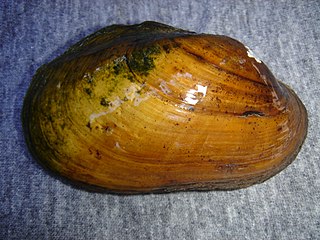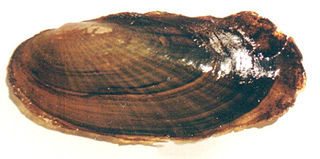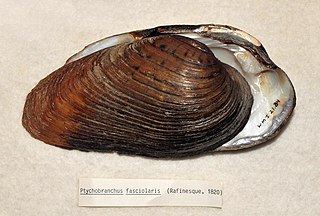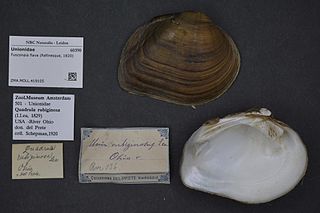
Epioblasma is a North American genus of freshwater mussels, aquatic bivalve mollusks in the family Unionidae, the river mussels. Most of the species in this genus have been lost in modern times, and the entire genus is threatened with the possibility of extinction.

Fusconaia escambia, the narrow pigtoe, is a freshwater bivalve mussel found in Alabama and northwestern Florida. The narrow pigtoe was first discovered in the Escambia River in Alabama and Florida.

Lampsilis abrupta, the pink mucket or pink mucket pearly mussel, is a species of freshwater mussel, an aquatic bivalve mollusk in the family Unionidae, the river mussels. This species is endemic to the United States.

Lampsilis is a genus of freshwater mussels, aquatic bivalve mollusks in the family Unionidae, the river mussels. There are over 100 species in the genus.

Hamiota altilis, the finelined pocketbook, is a species of freshwater mussel, an aquatic bivalve mollusk in the family Unionidae, the river mussels.

Lampsilis cardium is a species of freshwater mussel in the family Unionidae, the river mussels. It is known commonly as the plain pocketbook. It is widespread in eastern North America, where it is native to the Mississippi River and Great Lakes drainage systems.

Lampsilis higginsii is a rare species of freshwater mussel known as Higgins' eye pearly mussel or simply Higgins' eye. It is endemic to the United States, where it occurs in the upper Mississippi River and the drainages of some of its tributaries. It is threatened by the introduced zebra mussel. Lampsilis higginsii is a federally listed endangered species.

Hamiota perovalis, the orangenacre mucket or orange-nacre mucket, is a species of freshwater mussel, an aquatic bivalve mollusk in the family Unionidae, the river mussels.

Lampsilis powellii is a rare species of freshwater mussel known by the common name Arkansas fatmucket. It is endemic to Arkansas in the United States, where it occurs in the Ouachita, Saline, and Caddo River systems. It is one of two mussels endemic to Arksansas, the other being speckled pocketbook. It is a federally listed threatened species of the United States.
Lampsilis rafinesqueana, the Neosho mucket or Neosho pearly mussel, is a species of North American freshwater mussel endemic to Arkansas, Oklahoma, Illinois, Missouri and Kansas.

Potamilus leptodon, the scaleshell mussel or scale shell, is a species of freshwater mussel in the family Unionidae, the river mussels. This aquatic bivalve mollusk has disappeared from much of its historical range. It is endemic to the United States, where it is now present in four or fewer states; it is only found with any regularity in Missouri. It is a federally listed endangered species of the United States.

Ptychobranchus fasciolaris is a species of freshwater mussel in the family Unionidae, the river mussels. Its common name is kidneyshell.

Ptychobranchus is a genus of freshwater mussels in the family Unionidae. They are endemic to North America, and are mainly found in the Midwest and southeastern United States as well as Ontario, Canada. Several members of the genus are considered endangered species.
The triangular kidneyshell is a species of freshwater mussel, in the family Unionidae, the river mussels. It is endemic to Alabama in the United States, where it is known from several rivers and streams in the Mobile River Basin. It is a federally listed endangered species of the United States.
Ptychobranchus occidentalis is a species of freshwater mussel in the family Unionidae, the river mussels. It is endemic to the United States, where it is known from Arkansas, Kansas, Louisiana, Missouri, and Oklahoma. Its common name is Ouachita kidneyshell.

The glochidium is a microscopic larval stage of some freshwater mussels, aquatic bivalve mollusks in the families Unionidae and Margaritiferidae, the river mussels and European freshwater pearl mussels.

The shinyrayed pocketbook is an endangered species of freshwater mussel in the family Unionidae, the river mussels. This species is endemic to the United States in the states of Georgia, Florida, and Alabama.

Hamiota is a genus of freshwater mussels, aquatic bivalve mollusks in the family Unionidae, the river mussels.
Obovaria arkansasensis, the Southern Hickorynut, is a species of freshwater mussel, an aquatic bivalve mollusc in the family Unionidae, the river mussels. It lives in the southern United States, and has a complex life history including its larvae being parasitic on a fish host.

Fusconaia flava, the Wabash pigtoe, is a freshwater mussel in the family Unionidae. This species occurs in southern Manitoba and Ontario, Canada as well as in the eastern and midwestern United States from North Dakota to New York, south to Mississippi and Texas.



















